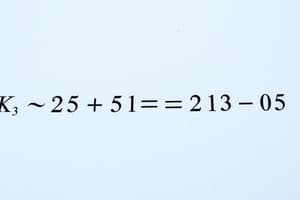Podcast
Questions and Answers
What is a characteristic of self-assembly in materials?
What is a characteristic of self-assembly in materials?
- The materials do not change shape.
- The materials do not form bonds.
- The materials do not move around.
- The materials interact with respect to each other and optimize their local environments. (correct)
What type of bonding is characterized by the exchange of electrons between atoms?
What type of bonding is characterized by the exchange of electrons between atoms?
- van der Waals forces
- Hydrogen bonding
- Ionic bonding
- Covalent bonding (correct)
What is an example of a self-organized system that arises from the interplay of long-range repulsions and short-range attractions?
What is an example of a self-organized system that arises from the interplay of long-range repulsions and short-range attractions?
- Ionic crystals
- Micelles
- Block copolymers
- All of the above (correct)
What type of interaction is characterized by the attraction between hydrophobic (water-repelling) and hydrophobic regions?
What type of interaction is characterized by the attraction between hydrophobic (water-repelling) and hydrophobic regions?
What is the term for the competition between two types of forces or interactions that leads to self-assembly?
What is the term for the competition between two types of forces or interactions that leads to self-assembly?
What is an example of a self-organized system that arises from the interplay of excluded volume and minimum space required?
What is an example of a self-organized system that arises from the interplay of excluded volume and minimum space required?
What type of force acts over a characteristic length scale?
What type of force acts over a characteristic length scale?
What is an example of a self-organized system that arises from the interplay of hydrophobic/hydrophilic incompatibility and covalent bonding?
What is an example of a self-organized system that arises from the interplay of hydrophobic/hydrophilic incompatibility and covalent bonding?
What is the term for the interaction between electric dipoles?
What is the term for the interaction between electric dipoles?
What type of interaction is characterized by the attraction between opposite charges?
What type of interaction is characterized by the attraction between opposite charges?
Flashcards are hidden until you start studying
Study Notes
Scales of Measurement
- Å (Ångström) is a unit of length equal to 10^-10 meters
- nm (nanometer) is a unit of length equal to 10^-9 meters
- mm (millimeter) is a unit of length equal to 10^-3 meters
- km (kilometer) is a unit of length equal to 10^3 meters
- AU (astronomical unit) is a unit of length equal to 1.49 x 10^11 meters
- ly (light-year) is a unit of length equal to 9.46 x 10^12 meters
Forces at Work in Self-Assembly
- van der Waals forces are a type of intermolecular force
- Brownian motion is a type of motion caused by collisions with surrounding particles
- Gravitation is a force that acts over long distances
- Electrostatics is a type of force that arises from the attraction and repulsion of charged particles
- Capillary forces are a type of force that arises from the interaction between surfaces and liquids
- Electromagnetic fields are a type of force that arises from the interaction between electrically charged particles
- Hydrogen bonds are a type of intermolecular force
- Coordination bonds are a type of intermolecular force
- Entropic interactions are a type of force that arises from the arrangement of particles in a system
Self-Assembly
- Self-assembly usually occurs in a fluid-like state, with water as the solvent
- Self-assembly can occur at different scales, including molecular, nano, and macro scales
- Self-assembly involves the optimization of local environments to produce a self-organized structure over a large volume
Applications of Self-Assembly
- Atomic, ionic, and molecular crystals can be created through self-assembly
- Self-assembled monolayers (SAMs) can be used in microfabrication, sensors, and nano-electronics
- Lipid bilayers and lipid films can be used in biomembranes, emulsions, and liposomes for drug delivery
- Phase-separated and ionic layered polymers can be used in nano-structured templates
- Liquid crystals can be used in displays and TVs
- Colloidal crystals can be used in nanosphere lithography and photonic band gap materials
Bonding and Forces Revisited
- Covalent bonds are a type of chemical bond
- Ionic bonds are a type of electrostatic force
- Hydrogen bonding is a type of intermolecular force
- van der Waals forces are a type of intermolecular force
- Hydrophobic interactions are a type of force that arises from the interaction between non-polar molecules and water
Competition Between Forces
- Self-assembly often occurs due to a competition between two types of forces or interactions
- The interplay of long-range repulsions and short-range attractions can lead to different types of self-assembly
- Examples of self-organized systems include micelles, lyotropic LC, block copolymers, ionic crystals, thermotropic LC, ferroelectric domains, and magnetic domains
Studying That Suits You
Use AI to generate personalized quizzes and flashcards to suit your learning preferences.




